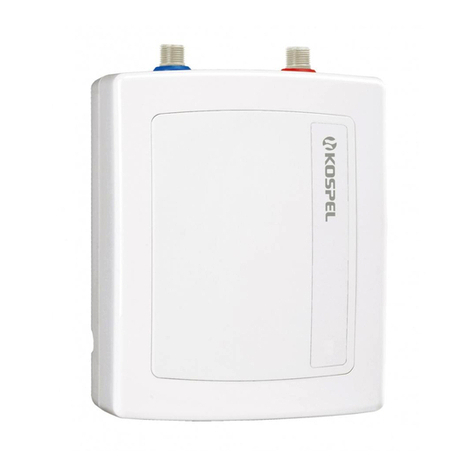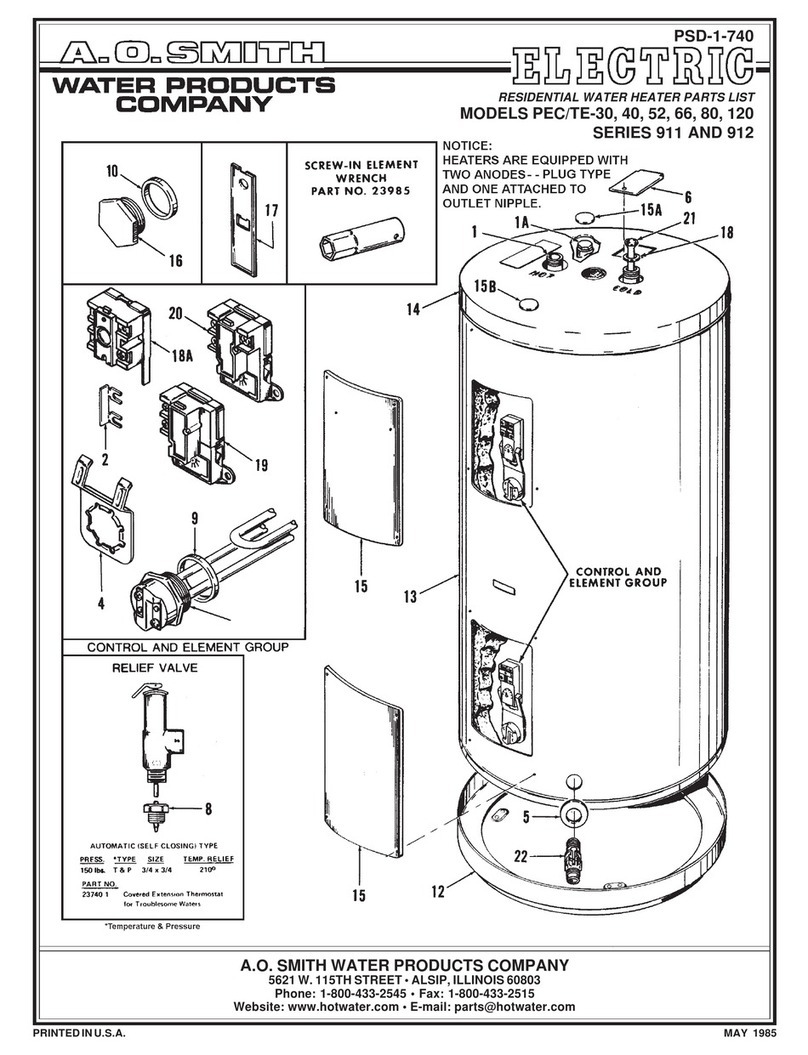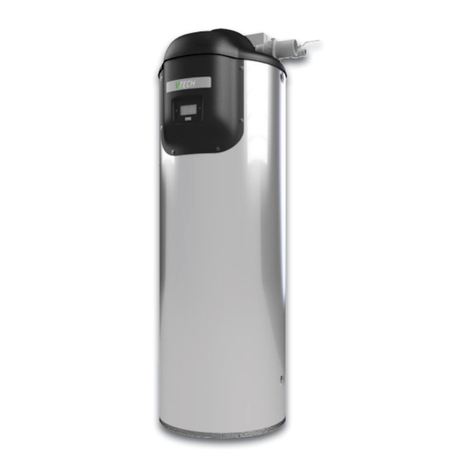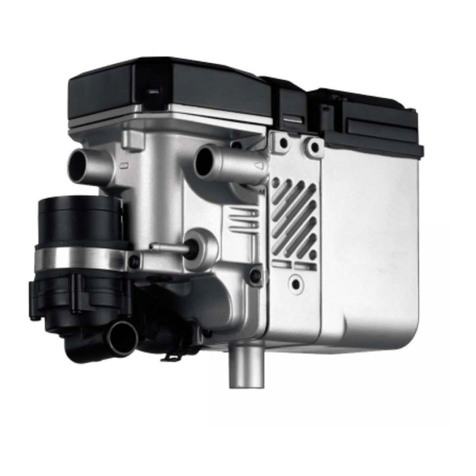HEATEC Firestorm Guide

Figure 1. Heatec Firestorm heater.
MAINTENANCE
Firestorm™ water heaters
Publication 1-10-218
CONTENTS
Safety .......................................................................... 1
Scope .......................................................................... 1
Intended users ............................................................ 2
Calcium clean-out ....................................................... 2
Cleaning strainers ....................................................... 4
Freeze protection ......................................................... 4
Checking water level switches .................................... 5
Checking the flame scanner ........................................ 7
Checking pilot gas pressure regulator .........................7
Checking high fuel gas pressure switch ...................... 7
Checking low fuel gas pressure switch ....................... 8
Checking high flue gas stack temperature switch ....... 8
Checking auxiliary contacts for water pump motor ..... 9
Checking auxiliary contacts for combustion
air motor ................................................................ 9
Checking low combustion air switch ......................... 10
Maintenance schedule ............................................... 12
SAFETY
Carefully following safety instructions in this docu-
ment will help you avoid serious injury or death. Read
instructions for each topic in their entirety before actu-
ally doing the work. Pay special attention to hazard
warnings that appear herein and on the heater. These
warnings identify known hazards, their severity and
how you can avoid them.
Warnings also appear at appropriate places in the
instructions.
Please be aware that if you deviate from the instruc-
tions, you could create unforeseen safety hazards. You
should perform step-by-step instructions in the order
given.
SCOPE
This document provides instructions for maintain-
ing Firestorm water heaters (Fig. 1). It also pro-
vides instructions on how to check various devices
in case you need to make sure they are working
properly.
Failure to heed certain recommendations may re-
sult in damage to the heater and/or shorten its life.
The components covered are mainly those that can
cause heater malfunctions when they go bad, need
cleaning, or get out of adjustment.
Because of differences in heaters, some instruc-
tions may not apply to your heater.
HEATEC TEC-NOTE

INTENDED USERS
Instructions in this document are intended for use
by qualified operators and maintenance personnel.
Some procedures require setting and testing parts
inside the heater electrical control panel while it is
open and electrical power is turned on.
Qualified persons are those who fully understand
electrical shock hazards and how to avoid them.
They also know how to take necessary precautions
against being burned when working around hot
surfaces and water heated to temperatures close to
its boiling point.
CALCIUM CLEAN-OUT
Build up of calcium inside the heater can be a mat-
ter of serious concern. Excessive buildup can lead
to heater malfunctions and heater damage. The rate
of calcium buildup varies widely depending on the
amount of calcium in the water supply and operat-
ing conditions.
Frequency of checks and down-time
The heater should be checked at least once a
month while in regular use to make sure calcium
buildup has not reached a point that affects opera-
tion of the heater. If no adverse signs are found,
the checks can be made less frequently. However,
if the heater is moved to a new location or if the
water supply is changed, revert back to monthly
checks.
When excessive calcium buildup is found you need
to plan down-time for clean-out. You may need to
allow a full day for clean-out. Do not delay any
longer than absolutely necessary.
Symptoms of excessive build-up
In due time you should be able to judge when it’s
time for a clean-out by the appearance of calcium
buildup on the packing in the heater.
In order to inspect the packing, shutdown the
heater and allow it to cool. Then open the lower
access door and pull out several pieces of pack-
ing (Fig. 2) from the center of the heater. You will
need to remove packing until you are near the
bottom center of the packing column. Calcium will
build up here first.
As you continue to check packing at regular inter-
vals you should also watch for other symptoms of
calcium buildup.
One symptom is the inability to heat the water to
the desired temperature as you have in the past.
Another symptom is an abnormally high stack
temperature and excessive vapor from the stack.
Another symptom is discoloration of the outside of
the heater shell.
We strongly recommend that you do not wait until
these symptoms appear. Instead you should devel-
op your ability to judge buildup by inspecting the
packing as indicated earlier.
Figure 2. Checking packing for calcium buildup.
Cleaning methods
There are two methods for cleaning calcium from
your heater. The first method requires shutting it
down and removing all the packing. The packing
must be soaked in a chemical intended for dissolv-
ing calcium. Once the calcium has been removed
from the packing, rinse it and put it back in the
heater.
The second method is to clean the inside of the
heater and packing simultaneously. This is done
by introducing a chemical cleaner into the top of
the heater. Do this while circulating water from
the reservoir through the heater with the burner
off. This may take several hours, depending on the
amount of calcium buildup.
To circulate its water, first fill the reservoir. Then
temporarily install a pipe or hose from the water
outlet valve to the secondary water connection
Publication 1-10-218
Page 2

Figure 3. Location of components on Firestorm heater.
Publication 1-10-218
Page 3
A. Stack temperature switch
B. Inlet water pressure switch
C. Inlet water temperature
gauge
D. Low gas pressure switch
(not visible in photo)
E. Gas pressure gauge
F. Control panel
G. Overflow connection
H. Water level indicator
I. High-high water level switch
J. High water level switch
K. Low water level switch
L. Low-low water level switch
M. Drain connection
N. Thermocouple
O. Check valve
P. Outlet water Y-strainer
Q. Automatic outlet water valve
R. Outlet water temperature
gauge
S. Outlet water pressure gauge
T. Manual outlet water valve
U. Burner
A
B
C
D
E
F
G
H
I
J
K
L
M
N
OPQR
S
T
U
V
W
X
Y
Z
AA
ABAC
AD
AEAF
V. High gas pressure switch
W. Manual gas leak test valve
X. Pilot gas valve
Y. Manual gas shut off valve
Z. Inlet water Y-strainer
AA. Manual inlet water valve
AB. Automatic inlet water valve
AC. Inlet water pressure
regulator
AD. Inlet water pressure gauge
AE. Secondary water connection
AF. Exhaust stack connection

(AE, Fig. 3). Then operate the water pump to cir-
culate the water containing the cleaning chemical.
The cleaning chemical will probably work better
soon after the heater has been shut down, while it
is still warm.
The chamber that contains the floats for water level
switches (I, J, K, L, Fig. 3) should be cleaned
separately.
Chemicals
A variety of chemicals are available for remov-
ing calcium deposits. Some contain sulfamic acid.
Others contain citric acid. You may wish to use
stronger chemicals on the packing while it is out of
the heater and milder chemicals inside the heater.
Keep in mind that chemicals circulating through
the heater will contact non-stainless steel parts,
such as circulating pump, bronze valves, seals, etc.
We suggest that you contact a chemical supplier to
find out what they recommend.
Packing (removal & replacement)
Dissolving calcium from the packing may take
several hours after it is removed from the heater.
Consequently your heater will be out of service
for an extended period unless you could simply
exchange the original packing with extra packing
already cleaned. That would shorten heater down-
time and allow you to clean the coated packing as
long as necessary.
To do that you would need extra packing. It is
absolutely essential for the extra packing to be
identical to the original packing. Otherwise the
heater will not perform properly! Please contact
Heatec for information about your packing.
If you plan to use extra packing be sure to scribe
the wall of the heater to indicate the level of the
original packing. When re-filling the heater with
packing, increase its level about one inch higher
than your scribe mark to allow for settling.
CLEANING STRAINERS
All Firestorm heaters have an inlet water Y-strainer
(Z, Fig. 3). Some also have an outlet water Y-
strainer (P, Fig. 3). Clogged strainers can cause
the heater to malfunction. Symptoms of a clogged
strainer include tripping the inlet water pressure
switch and/or abnormally high flue gas tempera-
ture. You should routinely check the strainers to
make sure they are not clogged.
Cleaning inlet water Y-strainer
Manually shut off the inlet water valve (AA, Fig.
3). Remove the plug from the inlet water Y-strainer
(Z, Fig. 3). Allow the water to drain.
Only a small amount of water will drain from the
strainer, so a bucket is all you need to catch the
water. Remove the strainer basket and clean it if
it is clogged. Replace the strainer basket and the
plug.
Cleaning outlet water Y-strainer
Allow the heater and water it contains to cool
down enough to avoid being burned from contact
with the shell and the water inside.
On heaters that have an outlet water strainer (P,
Fig. 3), open the drain valve that you installed in
the drain connection at the bottom of the heater.
Or remove the plug from the drain connection (M,
Fig. 3).
Drain several gallons of water until the level
shown on the water level indicator is slightly lower
than the outlet Y-strainer. So you may want to con-
nect a hose to the drain valve so the water can be
directed to a suitable area away from the heater.
Remove the plug from the outlet water Y-strainer.
Allow the water to drain. Only a small amount of
water will drain from the strainer, so a bucket is all
you need to catch the water. Remove the strainer
basket and clean it if it is clogged. Replace the
strainer basket and plug.
Close the drain valve at the bottom of the heater or
replace the plug in the drain connection.
FREEZE PROTECTION
Be sure to protect your heater from freezing if it is
located where temperatures remain below freezing
for several hours while not running. Otherwise wa-
ter in the heater could freeze and cause extensive
damage to heater components.
Publication 1-10-218
Page 4

Figure 4. Components outside the control panel.
One way to protect it from freezing is to drain all
water from the heater shell, float chamber, piping,
pump and strainer. All of these have drain plugs
except for piping, which may require loosen-
ing connections to allow drainage where water is
trapped.
As an alternative to draining water from the pip-
ing you may want to install heat tracing around the
piping.
CHECKING WATER LEVEL SWITCHES
Check water level switches (I, J, K, L, Fig. 3) if
you encounter any of the following symptoms:
• Pump won’t run
• Tank overflows
• Outlet water valve is inoperative
• Pump cycles on/off
To check the switches proceed as follows:
1. Obtain a scrap piece of stiff wire (or a coat
hanger) about 3 feet long. Bend one end of
the wire to form a small hook.
2. Open the control panel so you can observe
the lights on the PLC (B, Fig. 5).
3. Turn on the electrical power using the main
disconnect breaker (F, Fig. 5) inside the
panel.
Note: Earlier panel marking FIREYE FLAME MONITOR is now BURNER DISPLAY
Publication 1-10-218
Page 5

Figure 6. Flame scanner.
4. Open the top of the chamber where the
switches are installed.
5. Insert the hooked end of the wire into the
channel and grab onto the float of a switch.
6. Move the float up and down while observing
the light on the PLC. The light should go on
and off in response to float movement.
7. Repeat steps 5 and 6 for each of the remain-
ing switches.
Figure 5. Components inside the control panel.
Publication 1-10-218
Page 6
A B C D E F
H
G
IJKL
M
A. Voltage label
B. PLC (Programmable Logic Controller)
C. Fireye burner management control YB110
D. Terminals and relays
E. Alarm strobe light
F. Main disconnect breaker
G. Grounding lug
H. Control transformer
I. Circuit breakers and fuse blocks
J. Blower motor controller
K. Water pump motor controller
L. Equipment grounding strip
M. Fused terminals

CHECKING THE FLAME SCANNER
1. Make sure that the BURNER switch (Fig. 4) is
set to OFF.
2. Turn on power to the control panel while the
front panel is open.
3. With no flame present, check for approxi-
mately 560 Vac between terminals S1 and
S2 using an ac voltmeter.
4. Remove the flame scanner (Fig. 6).
5. Create a flame using a cigarette lighter, a
torch or a match. Hold the flame in front of
the scanner eye. The voltage should drop to
about 340 Vac and the Fireye burner display
should show the message FALSE FLAME and
should indicate a signal number. Otherwise,
either the flame scanner or its amplifier is
defective.
CHECKING PILOT GAS PRESSURE
REGULATOR
Figure 8. Manometer connected to tee at pilot gas line.
1. Connect a manometer to the tee of the pilot
gas line where it enters the burner.
2. Open the control panel and gain access to
the Fireye burner control (C, Fig. 5).
3. Turn on power to the control panel (F, Fig.
5) while the front panel is open.
4. Set BURNER switch (Fig. 4) to ON and let the
heater start through its purge cycle.
5. Wait for the burner display (Fig. 4) to show
the words IGNITION TIMING. Quickly place
the switch marked CHECK/RUN on bottom
of Fireye burner control (C, Fig. 5) to the
position marked CHECK. This will hold the
timing sequence while you check/adjust the
regulator.
6. Check that the manometer indicates ap-
proximately 3 inches of W.C. or as specified
for your burner in the burner manual. If not,
adjust screw on the regulator to attain the
recommended setting.
7. Place switch marked CHECK/RUN on bottom
of Fireye burner control back to RUN. The
timing sequence should continue and opera-
tion should be normal.
CHECKING HIGH FUEL GAS PRESSURE
SWITCH
With the burner operating, remover the cover from
the high fuel gas pressure switch (Fig. 9). Be care-
ful not to touch the live terminals. Adjust the
switch to a lower setting that causes the switch to
open.
Figure 9. High fuel gas pressure switch.
The following reactions should occur, indicating
that the pressure switch is operating properly:
• The burner should shut down.
• The HIGH FUEL GAS PRESSURE light (Fig. 4) on
the control panel should go out. (All other
indicator lights on the panel will also go
out.)
Publication 1-10-218
Page 7

• Fireye burner display should read LOCKOUT
3-P INTLK OPEN.
Re-adjust the high pressure switch to its previous
position and reset its manual reset button. Reinstall
its cover.
CHECKING LOW FUEL GAS PRESSURE
SWITCH
Figure 10. Low fuel gas pressure switch.
Shut off the main gas manual shutoff valve (Y, Fig.
3) and set BURNER switch (Fig. 4) to ON. Remove
the plug from the tee fitting below the pressure
switch allowing gas to escape. The following reac-
tions should occur, indicating that the switch is
operating properly:
• LOW FUEL GAS PRESSURE light on control
panel (Fig. 4) should be the first light to
go out. (Subsequent indicator lights on the
panel will also go out.)
• Fireye burner display (Fig. 4) should read
LOCKOUT 3-P INTLK OPEN.
Reinstall plug in tee fitting. Slowly re-open the
main gas manual shutoff valve.
Reset the low fuel gas pressure switch (Fig. 10)
using its manual reset button. Reset the Fireye
control.
CHECKING HIGH FLUE GAS STACK
TEMPERATURE SWITCH
WARNING
Do not touch the exposed terminals (FIG. 12)
inside the stack temperature switch. Touching the
terminals could cause electrical shock causing
serious injury or death.
Figure 11. High flue gas temperature switch.
Figure 12. Inside of high flue gas temperature switch.
Publication 1-10-218
Page 8

Figure 13. Checking stack temperature at analyzer port.
With the burner operating, remove the cover from
the high flue gas temperature switch (Fig. 11).
1. Remove the plug from the analyzer port at the
base of the exhaust stack. Insert a thermom-
eter in the port and note the temperature of the
exhaust gas (Fig. 13).
2. Rotate the dial (Fig. 12) on the switch until its
setting is a lower value than the temperature of
the exhaust gas. Be careful not to slide the dial
towards the switch while rotating it. Otherwise
the dial may press on the small plunger in the
switch and prematurely trip the switch.
The following reactions should occur, indicating
that the switch is operating properly:
• The burner should shut down.
• The HIGH FLUE GAS STACK TEMPERATURE light
(Fig. 4) on control panel should be the first
light to go out.
• Burner display (Fig. 4) should read LOCKOUT
3-P INTERLOCK OPEN.
Rotate the dial to its previous setting, then reset
the manual reset button on the switch. Replace the
cover.
CHECKING AUXILIARY CONTACTS FOR
WATER PUMP MOTOR
With the burner operating, trip the breaker discon-
nect for the water pump motor (G, Fig. 15).
This should cause its auxiliary contacts (E, Fig.
15) to open. The following reactions should occur,
indicating that the contacts are operating properly:
1. The burner should shut down.
2. Fireye burner display (Fig. 4) should show
STANDBY L1-3 OPEN.
Reset the breaker disconnect for the water pump
motor.
CHECKING AUXILIARY CONTACTS FOR
COMBUSTION AIR BLOWER MOTOR
With the burner operating, trip the breaker discon-
nect for the combustion air blower motor (B, Fig.
15).
This should cause its auxiliary contacts (D Fig.
15) to open. The following reactions should occur,
indicating that the contacts are operating properly:
1. The burner should shut down.
2. The COMB. AIR MOTOR AUX. CONTACTS light
(Fig. 4) on control panel should be the first
light out.
3. Fireye burner display (Fig. 4) should read
LOCKOUT 3-P INTERLOCK OPEN.
Reset the breaker disconnect for the combustion
air blower motor.
Publication 1-10-218
Page 9

CHECKING LOW COMBUSTION AIR
SWITCH
Figure 14. Low combustion air switch.
Make sure that the BURNER switch (Fig. 4) is set to
OFF.
1. In the control panel unlatch the auxiliary
contacts (D, Fig. 15) for the combustion air
blower and physically remove it with wires
attached.
2. Pull out the blue plunger on the module and
hold it out to close its contacts.
3. Restart the burner. The COMB. AIR/ ALL LIMITS
MADE light (Fig. 4) should come on almost
immediately.
4. Trip the breaker disconnect for the combus-
tion air blower. The COMB. AIR/ ALL LIMITS
MADE light should go out within 4 to 5 sec-
onds. If not, remove cover from combustion
air switch (Fig. 14) and re-adjust it as fol-
lows: Turn the adjustment screw clockwise
to shorten the cut-off response time. Turn
it counterclockwise to lengthen the cut-off
response time.
Re-insert the auxiliary contacts module into the
breaker disconnect.
Publication 1-10-218
Page 10

Figure 15. Components of motor controllers inside the control panel.
Publication 1-10-218
Page 11
A. Breaker auxiliary contacts for combustion air blower motor
B. Breaker disconnect for combustion air blower motor
C. Contactor for combustion air blower motor
D. Auxiliary contacts for combustion air blower motor
E. Auxiliary contacts for water pump motor
F. Contactor for water pump motor
G. Breaker disconnect for water pump motor
H. Breaker auxiliary contacts for water pump motor
A
B
C
D
E
F
G
H

Heatec, Inc. 5200 Wilson Road Chattanooga, Tennessee 37410 www.heatec.com (423) 821-5200 (800) 235-5200 Fax (423) 821-7673
REQUIREMENT
WEEKLY
MONTHLY
QUARTERLY
YEARLY
Clean flame scanner. X
Check intake area of blower to make sure it is not blocked by foreign material and is
free from buildup of dirt. X
During normal operation check all pressure gauges and thermometers on heater and
record any changes from previous indications. X
Check all operating and limit controls and settings to make sure they are set properly
and are working properly. X
Check heater and piping to ensure there are no leaks. X
Check heater to ensure there is no structural damage to heater or signs of over-
heating. X
Check burner control linkage to make sure it is not binding or loose. X
Remove packing from inside heater and check to ensure that calcium buildup is not
excessive. X
Check strainers to ensure they are not clogged. X
Have exhaust stack gases analyzed and have burner tuned by a specialist X
Heatec Firestorm water heaters should be checked periodically according to the requirements below. Failure
to properly maintain your heater could result in a fire or explosion.
MAINTENANCE SCHEDULE
Firestorm™ water heaters
© 2010 Heatec, Inc.
Publication 1-10-218
Page 12
Table of contents
Popular Water Heater manuals by other brands
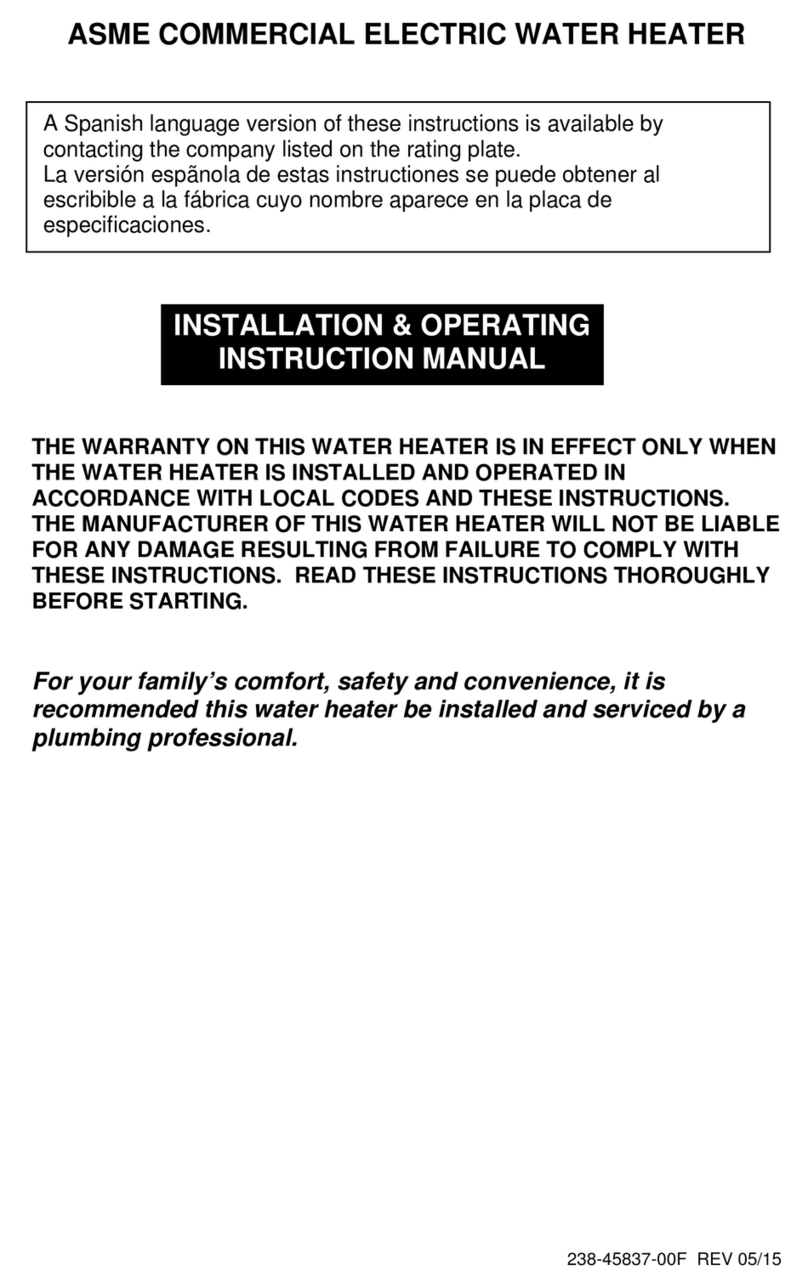
Bradford White
Bradford White 45837F Installation & operating instruction manual
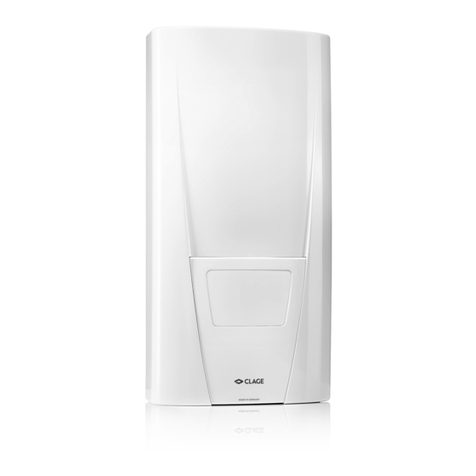
clage
clage DBX 18 BASITRONIC Operating instructions for the user
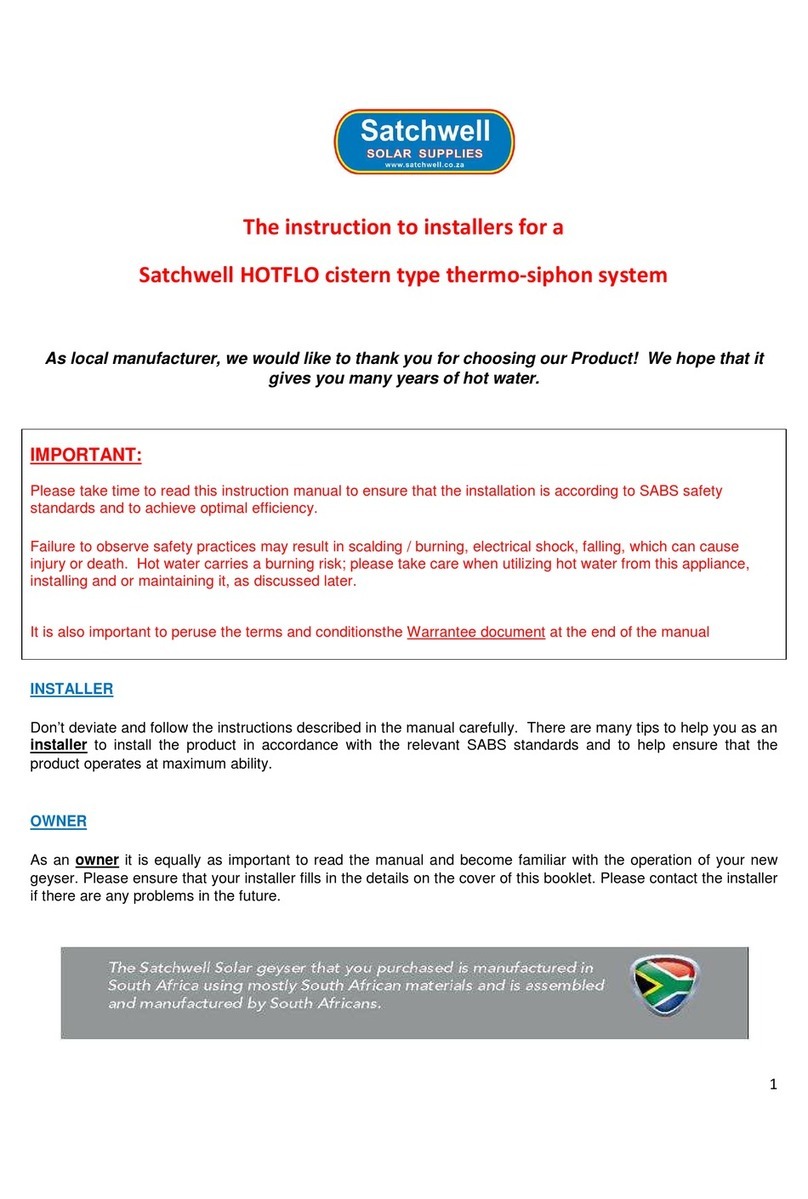
Satchwell
Satchwell HOTFLO Instruction

WaterPORT
WaterPORT DAY TANK owner's manual

EZ TANKLESS
EZ TANKLESS EZ OUTDOOR manual
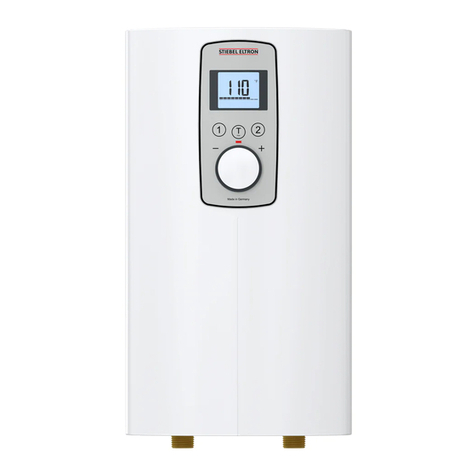
STIEBEL ELTRON
STIEBEL ELTRON DHC 3/3.5-1 Trend manual

andrews
andrews HIflo EVO HF 30/300 Installation and service manual

Thermor
Thermor VM75 instruction manual
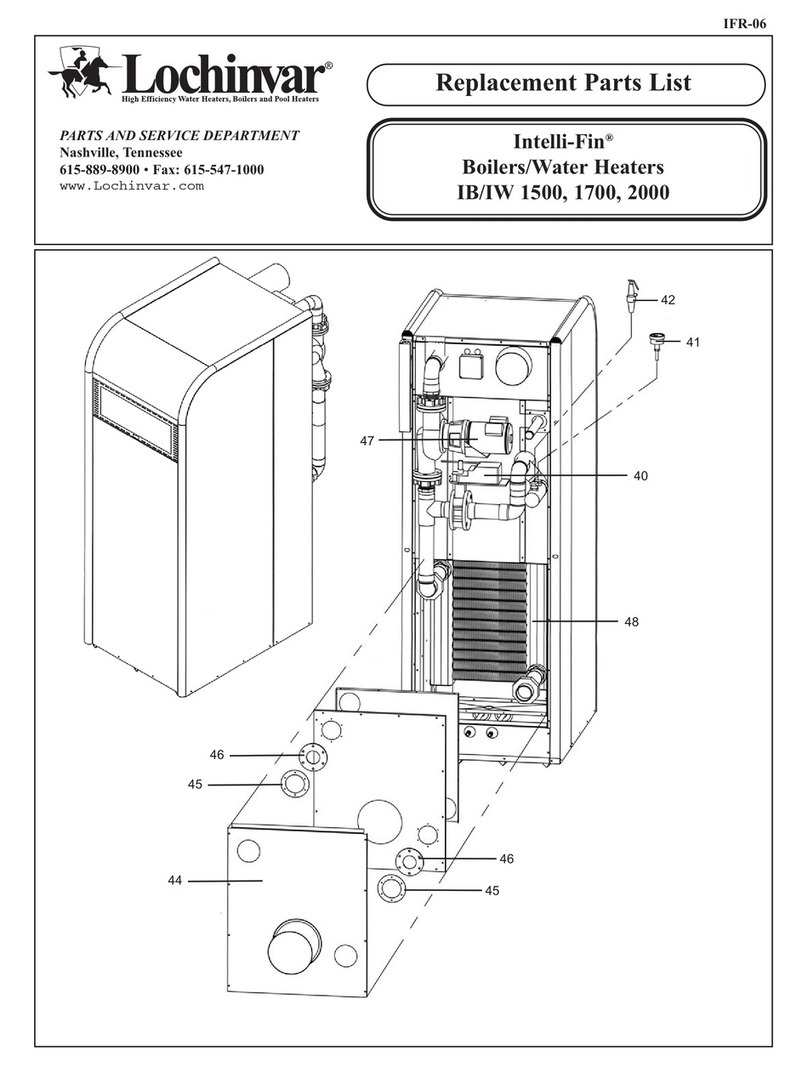
Lochinvar
Lochinvar Intelli-Fin IB 1500 Replacement parts list

Whirlpool
Whirlpool energysmart Residential Electric Water... Installation Instructions and Use & Care Guide
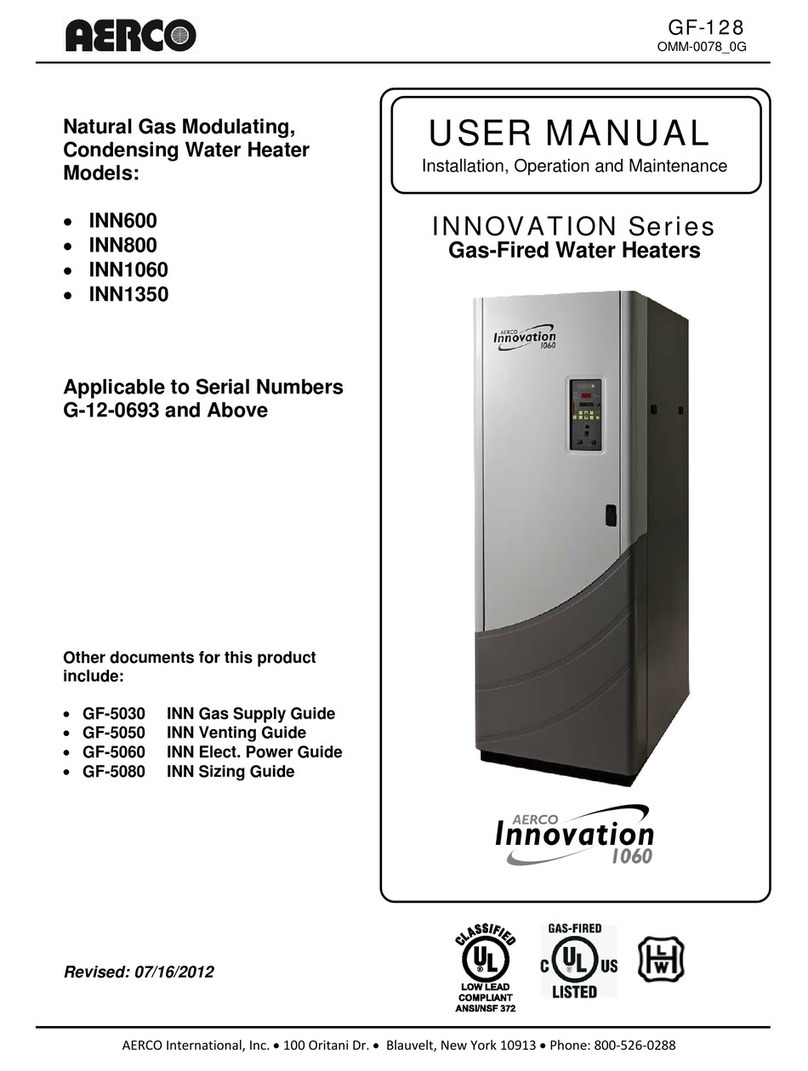
AER
AER INNOVATION INN600 user manual
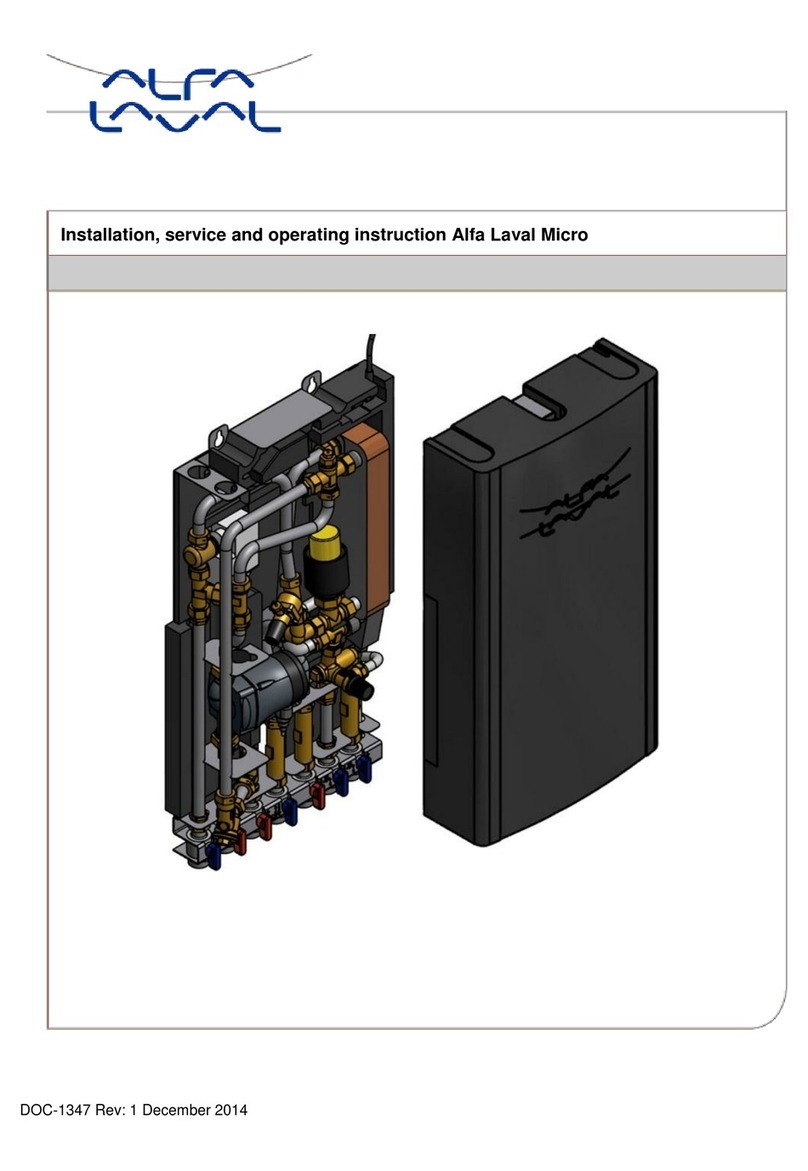
Alfalaval
Alfalaval Micro STC Installation, service and operating instruction
